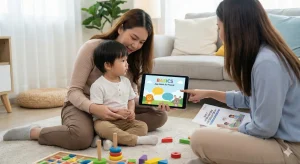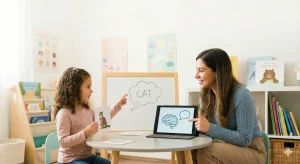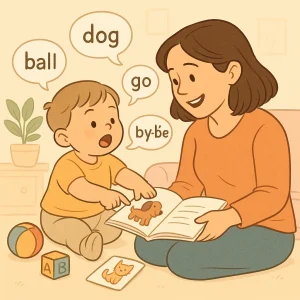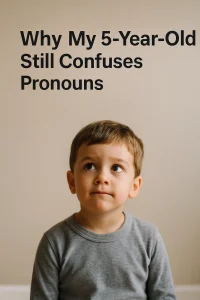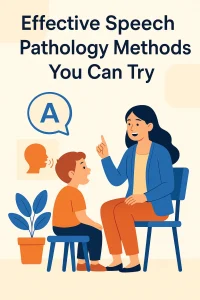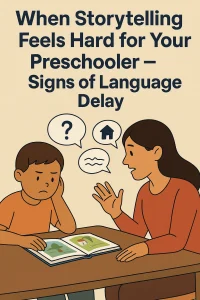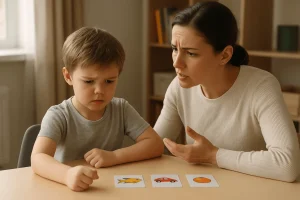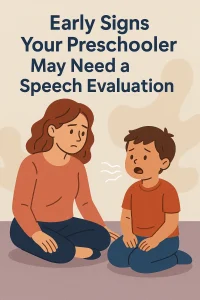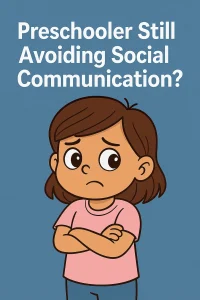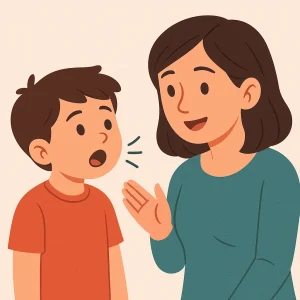What It Means When Your Toddler Doesn’t Start Conversations
Last Updated: September 1, 2025
It’s natural for parents to eagerly await their toddler’s first words — and even more exciting when they start using those words to ask questions, share thoughts, or tell tiny stories. But what happens when that moment doesn’t come? If your toddler doesn’t start conversations, it can leave you feeling anxious, confused, and full of questions.
Is this just part of your child’s unique personality? Or could it be an early sign of a speech delay or even autism?
You’re not alone — many parents begin to worry around age two, especially when their child seems to understand but rarely initiates communication. In this guide, we’ll break down what it really means when your toddler isn’t starting conversations, how to tell the difference between a speech delay and autism, and what steps you can take — including using powerful tools like speech therapy apps and autism communication apps at home.
Let’s explore what’s typical, what’s not, and how to help your child find their voice.
Free Speech Help for Kids
Concerned about speech delays? Book a free consultation with our expert speech therapist and get guidance tailored to your child’s needs.
Understanding Normal Toddler Speech Development
Every child develops at their own pace, but knowing what’s typical for toddler speech development can help you spot potential red flags early. If you’re wondering when a toddler should start talking or initiating simple conversations, this section breaks it down in a clear, parent-friendly way.
Receptive vs. Expressive Language: What’s the Difference?
Before toddlers start chattering away, they go through crucial stages of understanding. That’s where receptive language comes in — it’s your child’s ability to understand words, follow simple directions, and recognize familiar names or objects. For example, when you say, “Get your shoes,” and your toddler brings them over — that’s receptive language in action.
Expressive language, on the other hand, is your child’s ability to use words, gestures, or sounds to express their needs and ideas. This includes everything from babbling and pointing to eventually forming short sentences like “want juice” or “go park.”
Both types of language develop together — but some children may show strong understanding without initiating conversations. That’s why it’s important to observe how your toddler both understands and communicates.
When Should a Toddler Start Talking?
Most children begin saying their first real words around 12 months — words like “mama,” “dada,” or “bye-bye.” But between 18 to 24 months, you’ll typically see a big leap in speech skills. This is often referred to as a speech explosion — where vocabulary rapidly expands, and toddlers start combining words.
Here are some common speech milestones between 18–24 months:
- By 18 months, toddlers usually say at least 10–20 clear words
- They can point to familiar people, animals, or objects when named
- By 24 months, most toddlers use two-word phrases like “more juice” or “go out”
- They may begin asking simple questions, repeating words, or labeling objects
If your child isn’t using words to get your attention, ask for help, or engage in basic back-and-forth interaction by age two, it may be time to explore early language development support.
Download Your Free Speech Milestones Checklist
Want a clear guide to track your toddler’s speech progress? We’ve created a simple, age-by-age free speech milestones checklist that you can access from home. It covers receptive and expressive language goals for children aged 12–36 months.
Why This Matters
Understanding the timeline for toddler speech development helps you set realistic expectations — and recognize when something may need closer attention. Whether your child is just a quiet thinker or showing signs of speech delay, being informed is the first step toward giving them the support they need.
Why Isn’t My Toddler Starting Conversations?
If your child seems to understand what you say but rarely speaks up on their own, it can be concerning — and confusing. You may be asking yourself, “Is my toddler just a late talker, or is this a sign of something more serious?” Understanding the difference between a simple language delay and a more significant toddler communication delay can help guide your next steps.
Common Reasons Your Toddler May Not Be Talking Yet
Let’s start with the basics: Not all delays mean something is wrong. There are several common, often temporary, reasons why a toddler might not initiate conversations — even if they’re developing well in other areas.
1. Shyness or Temperament
Some children are simply quieter by nature. If your toddler prefers observing rather than speaking, they may still be building confidence in social situations. Shy toddlers often take longer to warm up, especially around unfamiliar people, but still show progress in their speech over time.
2. Bilingual or Multilingual Environment
If your toddler is exposed to more than one language at home, they might take longer to start speaking fluently in either. This is completely normal and usually temporary. While it might look like a language delay in toddlers, bilingual children are often just processing more input before they start expressing themselves.
3. Hearing Issues (e.g., Ear Infections)
Frequent ear infections or undiagnosed hearing problems can make it harder for toddlers to hear sounds clearly — which in turn affects how they speak. If your child isn’t responding to their name or seems to ignore verbal cues, a hearing check is a good first step.
Lack of Social Initiation vs. Inability to Speak
It’s important to understand what kind of communication delay your child is experiencing. There’s a big difference between a toddler who can’t talk versus one who won’t start conversations.
- A toddler who can’t speak might struggle with forming words, making sounds, or combining them into sentences. This is often seen in speech or language delays.
- A toddler who doesn’t initiate conversation, even if they can talk, may be showing signs of social communication challenges. They might answer questions but not ask them, or they may speak only when prompted — not to share or engage on their own.
This distinction is especially important when evaluating whether your child is a late talker or showing early signs of a developmental delay, such as autism spectrum disorder.
What Comes Next?
If your toddler isn’t starting conversations and you’ve ruled out common causes like shyness or hearing issues, it might be time to look deeper. In the next section, we’ll explore how to tell the difference between a speech delay and potential signs of autism — and what to watch for as your child grows.
Speech Delay or Autism? How to Tell the Difference
If your toddler isn’t talking much or rarely starts conversations, you may find yourself asking one of the hardest questions:
“Does my toddler have autism, or is it just a speech delay?”
It’s a question that brings a mix of worry, guilt, and confusion for many parents — and it’s completely normal to feel that way. The good news is that by learning to spot the key differences between speech delay and autism, you’re already taking a meaningful step toward helping your child.
What’s the Difference Between Speech Delay and Autism?
Both speech delays and early signs of autism in toddlers can involve limited verbal communication. However, they stem from very different causes and affect development in unique ways.
- A child with a speech delay typically wants to interact and communicate — they just have trouble forming words, pronouncing sounds, or combining words into sentences. Their social engagement is often intact, even if verbal skills are behind.
- In contrast, a child with autism spectrum disorder (ASD) may struggle with both language and social communication — including things like eye contact, gestures, and understanding social cues.
Knowing the signs to look for can help you distinguish between the two.
Key Behavioral Signs to Watch For
Let’s break down some common behaviors and how they tend to show up in speech delay vs. autism:
| Behavior | Speech Delay | Autism |
|---|---|---|
| Eye Contact | Normal or strong | May avoid or find it uncomfortable |
| Use of Gestures (e.g., pointing, waving) | Uses gestures to communicate | Limited or absent use of gestures |
| Pretend Play | Engages in simple pretend games (e.g., feeding a doll) | Rare or repetitive play, may not show imagination |
| Social Initiation | Tries to get your attention, responds to name | May not respond to name, may not seek shared attention |
| Emotional Expression | Cries, laughs, and reacts appropriately to situations | Emotional reactions may seem flat or unpredictable |
| Repetitive Behaviors | Rare | More common (e.g., hand flapping, lining up toys) |
If your child shows strong nonverbal communication, enjoys playing with others, and reacts appropriately to emotions but struggles to speak — it may point more toward a speech or language delay. On the other hand, if there are consistent challenges with social interaction, emotional connection, and play patterns, these could be early signs of autism.
What If You’re Still Not Sure?
You’re not alone — the line between speech delay and autism can be subtle, especially in toddlers under three. But early support makes a huge difference. If you’re wondering, “Does my toddler have autism?”, trust your instincts and talk to a pediatrician or speech-language pathologist. They can help guide you through a developmental screening and, if needed, refer you to a specialist.
Tip: Don’t Wait and See — Observe and Act
While some kids are simply “late talkers,” others may benefit from early intervention. Watching your child’s social behaviors — not just their words — can give you the best insight into what they need.
Up next, we’ll talk about when to seek professional help, and how tools like speech therapy app and autism support resources can play a valuable role at home.
Signs That May Indicate Autism in Toddlers
Every toddler is unique — some are chatty from the start, while others take a little more time to warm up. But when certain behaviors show up consistently and affect how your child communicates, plays, or connects with others, they could be autism red flags worth exploring.
If you’re concerned about your child’s development, especially around age two, it’s important to know the early signs of autism so you can seek support at the right time. Remember, spotting something early doesn’t mean something is wrong — it means you’re being proactive in giving your child the help they may need.
Common Autism Signs in 2-Year-Olds
While no single behavior confirms a diagnosis, a pattern of behaviors may suggest a closer look is needed. Here are some of the most recognized autism signs in 2-year-olds:
1. Limited Social Engagement
A toddler with autism may not respond to their name, avoid eye contact, or show little interest in playing with others. They might prefer to play alone or seem unaware of people around them. You may also notice a lack of “shared enjoyment” — such as showing you a toy or pointing something out just to share the moment.
2. Repetitive Behavior
Watch for repeated movements or actions, like hand flapping, rocking, or lining up toys over and over. Some children may fixate on spinning objects or get upset when a routine changes. These are common autism red flags, especially when combined with social withdrawal.
3. Sensory Sensitivities
Children on the autism spectrum often have sensory processing challenges. Your toddler may cover their ears for certain sounds, avoid certain textures, or be unusually sensitive to lights, smells, or touch. These reactions can appear intense and may seem out of place in everyday situations.
Nonverbal Communication Gaps
Autism affects not just what children say, but how they communicate in other ways. Many toddlers with autism show fewer gestures — such as pointing, waving, or showing objects. Facial expressions may be limited, and they may not mimic or imitate others as much as expected at this age.
While some children with autism are entirely nonverbal, others may speak but use language in unusual ways — repeating phrases (echolalia), scripting lines from shows, or speaking without real social connection.
If your child struggles to communicate needs, share experiences, or connect emotionally — even without words — it’s worth paying close attention.
The Role of Screening Tools and Autism Therapy App
If you’ve noticed any of the above behaviors and are asking yourself, “Could my child be on the spectrum?” — there’s no need to panic, but there is value in acting early.
Pediatricians and child psychologists use screening tools like the M-CHAT (Modified Checklist for Autism in Toddlers), free Autism checklist by Wellness Hub to assess risk factors. These tools are quick, parent-friendly, and can help determine whether your child should be referred for a full evaluation.
Takeaway: Early Awareness Builds Brighter Outcomes
Recognizing the early signs of autism in toddlers can feel overwhelming, but it’s also empowering. You don’t have to have all the answers right away — just knowing what to look for is a strong first step. With the right resources, screenings, and tools like autism communication apps your child can get the support they need to thrive.
Next, let’s talk about when to seek help, and what speech-language pathologists and child development specialists recommend for toddlers who aren’t yet starting conversations.
When to Seek Help for Your Child’s Speech Delay
It’s not uncommon for toddlers to reach developmental milestones at their own pace — but when it comes to speech, trusting your gut as a parent is incredibly important. If you’re wondering when to worry about your toddler’s speech, you’re not alone. Many parents face this concern, especially around the age of 2 when most children begin using words to express themselves.
While some kids are simply late talkers, others may benefit from extra support — and the sooner that support begins, the better the outcome.
What Pediatricians Want You to Know
Most pediatricians conduct routine developmental checkups during your child’s early years. These visits are an ideal time to bring up any concerns about speech or language. If your toddler isn’t saying simple words like “mama,” “ball,” or “more” by 18 months, or isn’t combining two words by age 2, your pediatrician may recommend taking a closer look.
They may suggest a hearing evaluation (to rule out auditory issues) or refer you to a speech-language pathologist — a specialist trained to assess and treat communication delays.
Don’t be afraid to ask questions like:
- “Is my child’s speech where it should be for their age?”
- “Do they need an evaluation for a speech delay?”
- “Should we start therapy now, or wait and see?”
Being proactive can make a significant difference, especially if your child is also showing signs of limited social interaction or struggles to understand simple directions.
Why Early Diagnosis Matters — Especially Before Age 3
Research shows that early intervention for speech delay — especially before the age of 3 — is linked to better language skills, stronger social development, and improved confidence in children.
During the first three years of life, a child’s brain is developing rapidly. This “critical window” is when therapy and structured support can have the biggest impact. Early identification also gives you, as a parent, the tools to support your child at home — through play, routines, and even speech therapy app for 2-year-olds designed by language specialists.
Waiting too long to act can mean missing this key developmental window, making it harder (though not impossible) to catch up later.
What to Expect from a Speech-Language Pathologist (SLP)
A speech-language pathologist will conduct a thorough evaluation of your child’s communication skills. This includes:
- Understanding how your child responds to sounds and speech
- Observing how they express themselves using words, gestures, or play
- Assessing receptive language (what they understand) and expressive language (what they can say)
Based on this evaluation, the SLP may recommend:
- Regular speech therapy sessions (in-person or online)
- At-home exercises and strategies for parents
- Use of interactive speech therapy tools, including apps tailored to toddlers
The Sooner You Act, the Better the Outcome
Knowing when to seek help for your child’s speech delay isn’t always easy, but acting early can make a world of difference. If your toddler is not talking, struggles to follow directions, or isn’t initiating conversations by age 2, don’t wait for it to “fix itself.”
There’s no harm in asking questions — only benefit in finding answers. Early support gives your child a stronger start, and gives you peace of mind.
In the next section, we’ll explore how speech therapy apps can complement professional therapy and become a playful part of your daily routine at home.
How Speech Therapy Apps Can Support Your Toddler at Home
When your toddler is struggling with communication, every small step matters — and so does every tool you use to support them. While traditional speech therapy is incredibly valuable, many parents today are also turning to speech therapy apps for toddlers as a convenient, engaging way to reinforce learning right from home.
These apps don’t replace a speech-language pathologist, but they do act as powerful tools to help children practice and build their skills in a low-pressure, playful environment. And for toddlers who need repetition, routine, and consistency, that kind of at-home support can make all the difference.
How Do Speech Therapy Apps Work?
A good speech development app is designed to feel like play — not work. Toddlers are naturally curious and responsive to bright visuals, sounds, and movement. Quality apps use this to their advantage by incorporating:
- Interactive games that teach naming, labeling, and sentence building
- Voice repetition and imitation tasks that help with sound production
- Daily routines that focus on real-life situations, like asking for food, greeting family, or identifying body parts
- Reinforcement tools like stickers, rewards, or music to keep kids engaged
The goal is to make speech practice part of the child’s everyday world — whether during snack time, playtime, or bedtime.
Features to Look for in the Best Speech App for Toddlers
Not all apps are created equal. When choosing a speech therapy app for toddlers, look for features that match your child’s developmental level, attention span, and needs. Here are a few things that make a big difference:
1. Age-Appropriate Prompts
Choose apps specifically designed for toddlers — they should use simple words, clear images, and gentle prompts. Complex instructions or too much visual clutter can be overwhelming.
2. Therapist-Backed Content
Look for apps developed in collaboration with speech-language pathologists (SLPs). These apps often follow developmental speech milestones and evidence-based strategies.
3. Parent Dashboard or Progress Tracker
Good apps offer tools that allow you to monitor your child’s progress — how many words they’ve practiced, how often they use the app, and what areas need extra support.
4. Customization and Flexibility
The best speech apps let you choose activities based on your child’s ability — whether they’re just beginning to babble or already forming short sentences.
Why Parents Love Using Speech Apps at Home
- Convenience: Use the app during your morning routine, car rides, or bedtime.
- Consistency: Repetition is key to language development, and daily use of an app makes that easy.
- Confidence: Kids often feel less pressure when practicing speech skills through play.
Whether your child is in therapy or not, using a speech development app at home can bridge the gap between sessions, give your child more practice, and help you stay involved in their progress.
Try Our Therapist-Recommended Speech Therapy App for Toddlers
Looking for a trusted way to support your child’s speech at home?
Explore our app-based solution here — designed by child development experts, with age-appropriate activities, progress tracking, and daily routines that fit into your lifestyle.
Whether your toddler is a late talker or working through a communication delay, our app gives you the tools to help them grow — one word at a time.
Autism Apps That Encourage Communication in Nonverbal Toddlers
For parents of toddlers on the autism spectrum, one of the biggest challenges is finding effective ways to support communication — especially when a child is nonverbal or has limited expressive language. While every child is different, many families have found that using the right autism communication app can open powerful new doors for connection.
Today’s technology offers more than just screen time. With the help of autism apps for kids, even toddlers who aren’t yet using words can learn to express needs, follow routines, and identify emotions — all at their own pace.
What Are Autism Communication Apps?
An autism app for kids is designed specifically to support developmental challenges related to language, social interaction, and routine. These apps often include:
Visual Schedule Tools
For many children with autism, knowing what comes next reduces anxiety and increases participation. Visual schedules use pictures to walk through routines like getting dressed, brushing teeth, or transitioning between activities. Apps with customizable visual schedules help children build independence and reduce meltdowns.
AAC Tools (Augmentative and Alternative Communication)
Apps for nonverbal autism often include AAC features — like digital picture boards, symbol-based communication systems, or simple touch-to-speak buttons. These tools help children communicate basic needs like “I’m hungry” or “I want to play,” even if they don’t use verbal language yet.
Read More: Understanding Augmentative and Alternative Communication (AAC) for Your Child
Emotional Labeling and Social Stories
Many autism apps help toddlers recognize emotions in themselves and others. Through interactive games or story-based formats, kids can learn to label feelings like “happy,” “frustrated,” or “scared” — an essential part of developing emotional regulation and social understanding.
Use at Home — and in Therapy Sessions
One of the biggest benefits of these apps is their flexibility. You can use them during:
- Daily routines (e.g., mealtime, bath time, outings)
- Speech or occupational therapy sessions
- Quiet time or solo play to build independence
- Transitions between activities, which are often stressful for autistic toddlers
Therapists often recommend certain apps to reinforce what’s being taught during in-person sessions, giving children more consistency and practice outside of the clinic.
Free vs Paid Autism Apps — What Should You Choose?
There are both free and paid autism communication apps, and the best option depends on your child’s needs and your goals.
- Free apps are a great place to start, especially if you’re new to using tech-based tools. Many offer basic visual schedules or simple AAC features.
- Paid apps usually offer more robust features — such as therapist dashboards, progress tracking, in-depth customization, and access to professional-designed social stories or language packs.
The key is to test and observe: What keeps your child engaged? What makes them smile, respond, or communicate more? What fits into your daily life?
Final Thoughts
When chosen thoughtfully, apps for nonverbal autism can do more than support communication — they can foster confidence, reduce frustration, and strengthen the bond between you and your child. Whether you’re building a routine, introducing symbols, or teaching feelings, an autism communication app can be a trusted companion on your journey.
Fun and Easy Ways to Encourage Conversation at Home
You don’t need to be a speech therapist to help your toddler communicate. In fact, some of the best tools to help your toddler start talking are already part of your daily routine — all you need is a little creativity, patience, and the right kind of play.
From language development games to simple bonding moments, these fun and easy activities can encourage your child to use words, gestures, and expressions in meaningful ways. And the best part? They don’t feel like work — they feel like play.
1. Pretend Play with Everyday Items
Pretend play is a powerful tool for boosting communication skills. Set up a mini kitchen, doctor’s kit, or animal farm using toys you already have — or even everyday household items.
Encourage your toddler to “cook,” “feed the baby,” or “fix the car” while you play along, modeling simple phrases like:
- “Yummy soup!”
- “Baby is sleepy.”
- “Uh-oh, car is broken.”
This helps introduce new vocabulary while building imagination and storytelling — all of which support early language development.
2. Turn-Taking Games
Turn-taking teaches the rhythm of conversation: I speak, you respond. Use simple games like rolling a ball back and forth, stacking blocks, or taking turns with toy cars.
Each time it’s your toddler’s turn, prompt them with phrases like:
- “My turn… now your turn!”
- “Go car!”
- “Can I have it?”
These speech activities for toddlers naturally encourage waiting, responding, and initiating — the building blocks of communication.
3. Picture Books with Repetition
Choose interactive picture books with big, clear images and simple, repetitive text. Ask your child questions as you read, like:
- “What’s this?”
- “Where’s the dog?”
- “Can you say ‘moo’?”
Pause often and give them time to respond, even if it’s just a sound or gesture. Books with animal noises, lift-the-flaps, or peekaboo elements are especially helpful for language development games at home.
4. Combine Play with Screen-Based Tools
Used mindfully, screen time can support your efforts — especially when paired with speech therapy apps or toddler-friendly educational videos.
Apps that encourage naming, sound imitation, and turn-taking can be used during playtime or quiet moments. Just remember:
- Choose age-appropriate content
- Play together to model responses
- Limit screen time and balance it with real-world interaction
When you combine play-based learning with interactive tech, you create a well-rounded environment that helps your toddler thrive.
Parental Coaching Tips to Maximize Progress
- Follow your child’s lead: Talk about what they’re looking at or playing with.
- Model, don’t pressure: Say the word a few times, but don’t force them to repeat it.
- Celebrate every attempt: Whether they say the full word or just a sound, show encouragement.
- Keep talking: Narrate your daily activities in simple language — “Now we wash hands,” “Let’s open the door,” etc.
The more language your toddler hears and sees in action, the more likely they are to use it.
You Know Your Toddler Best — Take the Next Step
As a parent, you are your child’s biggest advocate. If you’ve noticed that your toddler isn’t starting conversations, seems quieter than peers, or isn’t hitting typical language milestones — trust your instincts. It’s okay to have questions. It’s okay to feel concerned. And it’s more than okay to seek answers.
Every child develops in their own way, but early support makes a lasting difference. Whether your little one is a late talker or showing signs of a communication delay, getting help sooner rather than later can lead to better outcomes in speech, social development, and confidence.
Today, you don’t have to wait for appointments or feel helpless at home. With the right mix of tools — like interactive speech therapy apps, play-based activities, and professional guidance — you can actively support your child’s growth every single day.
You’ve taken the time to understand the signs, explore the possibilities, and learn how to help. Now, it’s time to take that next step.
Conclusion
If your toddler isn’t starting conversations or is slower to talk, trust your instincts. You know your child better than anyone. Early help can make a big difference. Whether your child has a speech delay or needs extra support, simple tools like speech therapy apps and fun home activities can really help.
Don’t wait and worry — take action now.
Explore our evidence-based speech therapy app for toddlers with delayed conversation skills.
It’s designed by experts to help your child learn to speak and connect in a fun, easy way — right from home.
Frequently Asked Questions:
1. Is it normal if my 2-year-old doesn’t talk or start conversations?
Some toddlers talk later than others, but if your 2-year-old isn’t starting conversations or using two-word phrases, it may be a speech delay. It’s a good idea to talk to your doctor or a speech therapist.
2. What are the early signs of autism in toddlers?
Autism signs in 2-year-olds may include no eye contact, not responding to their name, not pointing or showing things, and repeating actions like hand flapping. If you notice these signs, a developmental checkup can help.
3. How can I help my toddler start talking at home?
You can use speech activities for toddlers like pretend play, turn-taking games, and reading picture books. Talking often and using speech therapy apps also helps build language skills.
4. When should I worry about my toddler’s speech delay?
If your child doesn’t say any words by 16–18 months or isn’t putting two words together by 2 years old, it’s time to check with your pediatrician. Early intervention works best.
5. What is the difference between speech delay and autism?
In speech delay, the child may understand you and want to talk but struggles with words. In autism, the child may also have trouble with social skills like eye contact, gestures, and pretend play.
6. Do speech therapy apps really help toddlers?
Yes! A good speech therapy app for toddlers uses fun games, sounds, and pictures to help kids learn new words and practice talking. They’re helpful for home use alongside therapy.
7. Which is the best speech therapy app for 2-year-olds?
Look for a speech development app made by experts, with simple activities, clear images, and progress tracking for parents. Some apps also include daily routines and games your child can enjoy.
8. Are there free autism apps for nonverbal toddlers?
Yes, many autism apps for kids are free or have free versions. They include tools like picture boards, visual schedules, and voice buttons to help nonverbal toddlers communicate.
9. Should I see a speech-language pathologist for my toddler?
Yes, if your toddler is not talking or seems delayed, a speech-language pathologist (SLP) can do an evaluation and guide you on what to do next.
10. Can I use apps and therapy together for speech delay?
Absolutely. Speech therapy apps work great when used with regular therapy sessions or daily practice. They help you support your child at home in a fun and easy way.
About the Author:
Anuradha Karanam
Speech-language pathologist (7+ years of experience)
Anuradha Karanam is a skilled speech-language pathologist with over 6 years of experience. Fluent in Tamil, Telugu, Hindi, and English, she specializes in parent counseling, speech sound disorders, fluency assessment, and speech-language evaluations. Anuradha excels at working with children with developmental disorders, offering creative and effective therapy programs. Currently, at Wellness Hub, she holds a BASLP degree and is registered with the RCI (CRR No A85500). Her patience, ambition, and dedication make her a trusted expert in her field.
Book your Free Consultation Today
Parent/Caregiver Info:
Client’s Details:
* Error Message
